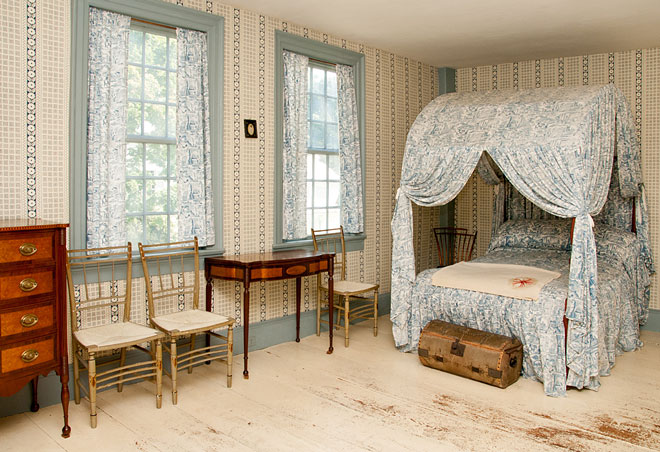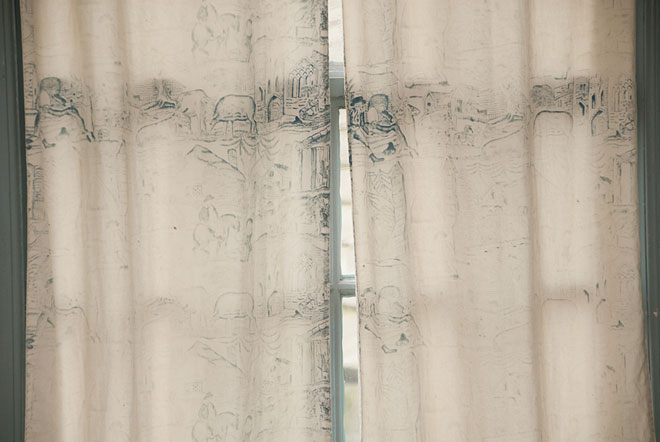One of the favorite stops on the Wells-Thorn House tour is the 1815 Bed Chamber. This airy, light-filled room is furnished with a neoclassical-style field bed in addition to a set of en suite (matching) roller printed bed hangings and curtains. These reproduction blue-printed patterned textiles are based on a surviving, original piece of fabric with a history of ownership by Dennis Stebbins (1778-1842) of Deerfield [HD 87.835]*

Even though the room’s windows are outfitted with Lexan panels, which filter out the most harmful ultraviolet (UV) rays, the curtains in the room have been replaced twice on account of excessive fading from sunlight. Studies have found that blocking all of the UV content of light does not eliminate damage for most light-sensitive materials, but will slow down the rate of fading and other damage by a factor of about three. The visible light spectrum can also be damaging to fabrics and other objects. All organic materials, and a few inorganic materials, are susceptible to damage by light. Light fades textiles, photographs, watercolors, and dyed basketry. Light discolors and destroys varnishes, paper and glues. In addition, light exposure leads to embrittlement and structural weakness in paper and textiles. These are fundamental and irreversible forms of deterioration.
During the recent Institute of Museum and Library Services-funded conservation survey with consultants Mary Jo (MJ) Davis and Barbara Moore, Collections Manager Ned Lazaro and I questioned why just one of the window curtains in the room was fading more rapidly than the others. Our conservators were quick to point out that the Lexan panel was removed from that window during the summer months to allow for more ventilation in the house. The difference between that curtain and the others in the room was significant and a real wake-up call to the powerful effect of light on objects.

In the future Historic Deerfield staff will be studying new ways to further reduce the effects of light damage in the historic houses by using tinted Lexan panels, adding more curtains, shades, and scrims, replacing more historic textiles with reproductions, and instituting a schedule of textile rotations in the houses. Of course, any changes that reduce the levels of exterior light need to be coordinated with upgrades in interior lighting. As we work to secure the collections for the future, we also plan to accommodate the needs of our visiting public.
This project was made possible in part by the Institute of Museum and Library Services [MA-30-13-0006-13]. The Institute of Museum and Library Services is the primary source of federal support for the nation’s 123,000 libraries and 35,000 museums. Our mission is to inspire libraries and museums to advance innovation, lifelong learning, and cultural and civic engagement. Our grant making, policy development, and research help libraries and museums deliver valuable services that make it possible for communities and individuals to thrive. To learn more, visit the Institute of Museum and Library Services and follow IMLS on Facebook and Twitter.
*Dennis Stebbins of Deerfield, Massachusetts, was the oldest son of the twelve children of Joseph Stebbins (1749-1816) and Lucy (Frary) Stebbins (1754-1831). He grew up in a large gambrel-roofed house on Deerfield’s main street, just north of the current Deerfield Inn. In 1800, he married Lois Hawks (1781-1862), and they had ten children.